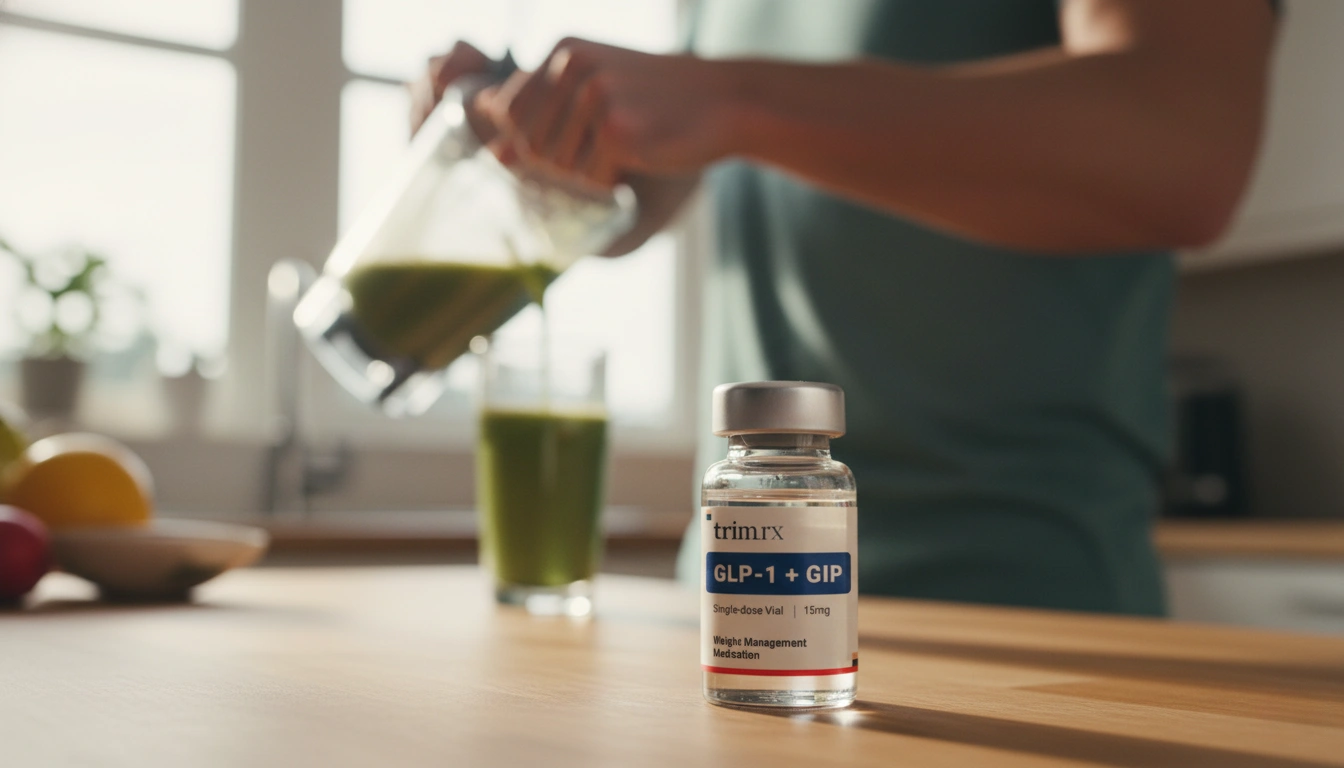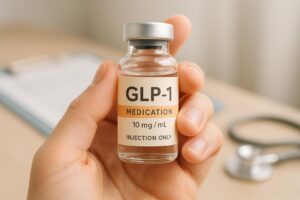Do GLP-1 Side Effects Go Away? Understanding the Journey of Treatment

Did you know that nearly 70% of individuals prescribed GLP-1 receptor agonists experience gastrointestinal side effects during their treatment? For many, this fact can be daunting, especially when starting a new medication to aid in weight loss or manage diabetes. At TrimRx, we understand that embarking on a weight loss journey can bring with it a myriad of questions, particularly regarding the side effects of medications like GLP-1s. In this blog post, we will delve into the common side effects associated with GLP-1 drugs, their duration, and what you can expect as you navigate your personalized weight loss plan with TrimRx.
Our aim is to provide you with a comprehensive understanding of GLP-1 medications, how they work, and the strategies we can employ to manage any side effects effectively. By the end of this article, you will not only know whether GLP-1 side effects go away but also how to approach them thoughtfully and safely.
Introduction
The advent of GLP-1 receptor agonists has transformed the approach to managing obesity and type 2 diabetes. These medications, including popular options like Ozempic® and Wegovy®, help regulate insulin, control appetite, and promote weight loss. However, like many effective treatments, they come with potential side effects. The question that often arises for new users is whether these side effects are temporary and, if so, when they might subside.
In this blog post, we will explore:
- The common side effects of GLP-1 medications
- The timeline for when these side effects typically occur
- Strategies to manage side effects effectively
- Insights into the effectiveness of these medications
- The importance of personalized care in weight loss journeys
At TrimRx, we believe in a holistic approach to weight loss that combines advanced medical science with empathetic support, ensuring our patients feel informed and empowered throughout their journey. So, let’s dive deeper into the world of GLP-1 medications and their side effects.
Understanding GLP-1 Medications
GLP-1 receptor agonists are a class of medications that mimic the action of the naturally occurring hormone glucagon-like peptide-1. These drugs help control blood sugar levels by stimulating insulin secretion, slowing gastric emptying, and reducing appetite. The most commonly prescribed GLP-1 medications include:
- Semaglutide (Ozempic®, Wegovy®)
- Liraglutide (Saxenda®, Victoza®)
- Dulaglutide (Trulicity)
- Tirzepatide (Mounjaro®)
These medications are typically prescribed to individuals with obesity or type 2 diabetes, and they have shown significant efficacy in promoting weight loss and improving metabolic health. At TrimRx, we offer personalized weight loss programs utilizing these medications, ensuring that patients receive tailored care based on their unique needs.
Common Side Effects of GLP-1 Medications
While GLP-1 medications can be highly effective, they also come with a range of potential side effects, particularly during the initial weeks of treatment or when doses are increased. The most common side effects include:
- Nausea
- Vomiting
- Diarrhea
- Constipation
- Stomach Pain
- Loss of Appetite
- Fatigue
Nausea and Gastrointestinal Issues
Gastrointestinal (GI) side effects like nausea, vomiting, and diarrhea are among the most frequently reported. Studies indicate that around 40-70% of patients experience these symptoms, particularly during the first few weeks of treatment. This is often due to the way GLP-1 medications affect stomach emptying and digestion.
Are These Side Effects Temporary?
For many patients, these side effects tend to be transient, with most individuals reporting improvements within a few weeks. In clinical trials, the median duration of nausea was reported to be approximately 8 days, while diarrhea and vomiting typically resolved within 3 days. However, it’s essential to note that some patients may experience prolonged or more severe symptoms, leading to concerns about continuing treatment.
Do GLP-1 Side Effects Go Away?
Now, the burning question: do GLP-1 side effects go away? The short answer is yes, for many individuals. Most patients find that GI-related side effects diminish over time as their bodies adjust to the medication. Here’s a deeper look at what to expect:
Initial Phase of Treatment
During the initial phase of treatment, side effects may be more pronounced as the body adapts to the medication. This is often when patients experience the most discomfort. It is crucial to communicate with healthcare providers during this phase to ensure that any discomfort is manageable and to discuss potential adjustments to the treatment plan.
Dose Adjustments
If side effects are significant, healthcare providers may recommend starting at a lower dose and gradually increasing it. This “start low, go slow” approach can help minimize side effects while allowing the body to acclimate to the medication.
Long-Term Use
For individuals who stick with their GLP-1 treatment, many report that side effects significantly lessen or even disappear after the initial adjustment period. Many patients successfully continue their medications without the persistent GI disturbances that may have troubled them at the beginning.
Strategies for Managing Side Effects
At TrimRx, we believe in a proactive approach to managing side effects, ensuring that our patients feel supported throughout their treatment journey. Here are some effective strategies to mitigate the impact of GLP-1 side effects:
Dietary Adjustments
-
Smaller, Frequent Meals: Eating smaller portions more frequently can help reduce the likelihood of nausea and other GI disturbances. It allows for easier digestion and can help manage hunger.
-
Stay Hydrated: Drinking plenty of fluids is essential, especially if experiencing diarrhea or vomiting. This helps prevent dehydration, which can exacerbate side effects.
-
Avoid Trigger Foods: Certain foods, such as fatty or spicy meals, may trigger or worsen nausea. Patients should be mindful of their food choices and avoid known irritants.
Medication Management
-
Gradual Dose Increases: As mentioned, starting at a lower dose and gradually increasing can help mitigate side effects. Always consult with your healthcare provider before making any changes to your medication regimen.
-
Antiemetics for Nausea: If nausea persists, healthcare providers may recommend medications to help manage these symptoms effectively.
Ongoing Support
-
Regular Check-Ins: Maintaining open communication with healthcare providers is crucial. Regular check-ins can provide opportunities to discuss side effects and adjust treatment as needed.
-
Educational Resources: At TrimRx, we provide educational resources to help patients understand what to expect and how to manage their treatment effectively.
The Role of Personalized Care
At TrimRx, our journey began with a vision to help individuals embrace healthier lifestyles through personalized care. We combine cutting-edge telehealth innovations with effective weight loss solutions, ensuring that our patients receive tailored support at every step. Our personalized weight loss programs, which include medications like GLP-1s, are designed to address each individual’s unique needs, preferences, and medical history.
By understanding that each patient’s experience with GLP-1 medications may vary, we focus on providing compassionate care that empowers individuals to achieve their weight loss goals sustainably. This includes:
- Comprehensive consultations to assess eligibility for GLP-1 medications
- Ongoing support and guidance throughout the treatment journey
- Personalized treatment plans tailored to individual needs
Conclusion
In conclusion, while starting GLP-1 medications can come with a range of initial side effects, many patients find that these effects diminish over time as their bodies adjust to the treatment. At TrimRx, we are committed to providing our patients with the tools and knowledge they need to navigate their weight loss journeys successfully.
If you are considering a personalized weight loss program or are curious about whether you qualify for GLP-1 medications, we invite you to take our free assessment quiz here. Together, we can explore the best path forward for your health.
FAQ
How long do GLP-1 side effects typically last?
Most side effects, particularly gastrointestinal ones, tend to last a few days to a couple of weeks. Many patients report significant improvement within the first month of treatment.
What can I do if the side effects are too severe?
If side effects are persistent or severe, it’s essential to consult your healthcare provider. They may recommend adjusting your dose or trying strategies to manage your symptoms.
Are GLP-1 medications safe for everyone?
GLP-1 medications are generally safe for many individuals, but they may not be suitable for everyone. A thorough assessment is necessary to determine eligibility.
Can I combine GLP-1 medications with other weight loss strategies?
Absolutely! GLP-1 medications can be part of a broader weight loss strategy that includes dietary changes, exercise, and lifestyle modifications.
What should I do if I experience severe side effects?
Seek immediate medical attention if you experience severe or concerning side effects, such as severe abdominal pain, persistent vomiting, or signs of dehydration.
At TrimRx, our commitment to transparency and individualized care ensures that your journey toward a healthier lifestyle is supported every step of the way. Let’s work together to make sustainable weight loss attainable for you!

Transforming Lives, One Step at a Time
Keep reading
Tracking Progress With GLP-1: What To Measure
Learn which metrics to track on GLP‑1 therapy—weight, waist, blood sugar, lipids, side effects, and non‑scale wins—and how often to monitor them.
Fatigue Solutions for Ozempic and Wegovy Users
Hydration, protein-rich meals, light activity, and better sleep can reduce medication-related fatigue and help maintain energy during weight-loss treatment.
GLP-1 Medication Side Effect Checker
Worried about GLP-1 medication side effects? Use our free checker for Semaglutide, Liraglutide, and more to learn what to expect and stay informed!



